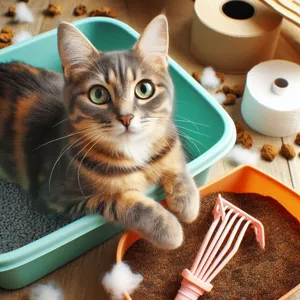For cat owners, maintaining a clean and fresh litter box is an essential part of ensuring a happy and healthy home for both feline and human inhabitants.
A clean litter box not only prevents unpleasant odors but also promotes good hygiene and encourages your cat to use it consistently. However, the task of litter box maintenance can often feel overwhelming, especially with the myriad of products and techniques available. In this blog post, we will delve into the art of litter box maintenance, providing you with top tips and tricks to keep your cat’s space pristine. From choosing the right litter type and box design to establishing a consistent cleaning routine, you’ll learn how to create an inviting environment for your furry friend while keeping your home smelling fresh and clean. Say goodbye to litter box woes and hello to a harmonious living space that both you and your cat will love!
1. Introduction: The Importance of a Clean Litter Box

When it comes to caring for our feline friends, one of the most crucial yet often overlooked aspects is maintaining a clean litter box. Imagine stepping into a space filled with unpleasant odors and unsightly messes—it’s enough to deter any cat from using their designated bathroom! A clean litter box is not just a matter of aesthetics; it plays a vital role in your cat’s health and well-being.
Cats are instinctively clean animals, and a dirty litter box can lead to stress and anxiety, resulting in undesirable behaviors such as inappropriate urination or defecation outside the box. Furthermore, a filthy litter box can become a breeding ground for bacteria and parasites, posing health risks not only to your cat but also to the entire household.
By mastering the art of litter box maintenance, you create a welcoming environment that promotes your cat’s natural behaviors and instincts. Regular cleaning not only helps to control odors but also fosters a sense of security for your pet, encouraging them to feel comfortable and safe in their space. Whether you’re a new cat owner or a seasoned pro, understanding the importance of a clean litter box is the first step toward nurturing a happy, healthy relationship with your furry companion. In the following sections, we will explore essential tips and tricks to ensure your cat’s litter box remains fresh, clean, and inviting, making both you and your pet happy!
2. Choosing the Right Litter Box for Your Cat
Choosing the right litter box for your cat is a fundamental step in ensuring their comfort and promoting good bathroom habits. Not all litter boxes are created equal, and finding the perfect fit for your feline friend can make all the difference in their litter box experience.
First and foremost, consider your cat’s size and age. Kittens may require a smaller, more accessible box, while larger breeds like Maine Coons will benefit from a spacious design that allows them to move around comfortably. Adult cats appreciate a box that offers ample room to turn around and dig, so opting for a larger option can help prevent messes outside the box.
Next, think about the type of litter box that best suits your cat’s personality. Some cats prefer covered litter boxes, which provide a sense of privacy and help contain odors and litter scatter. However, others may feel confined or anxious in a covered space, leading to avoidance of the box altogether. On the other hand, open litter boxes allow for easy access and ventilation, making them ideal for cats who value openness and visibility.
Don’t forget to consider the box’s height. Older cats or those with mobility issues may struggle with high sides, so a low-entry box can make a world of difference. Additionally, if you have multiple cats, a larger box or multiple boxes placed in different areas of your home can help reduce territorial disputes and ensure each cat has easy access.
Lastly, think about the materials. Plastic boxes are the most common and easy to clean, but there are also other options like biodegradable or more aesthetically pleasing designs that fit with your home decor. Ultimately, the right litter box should cater to your cat’s needs while also fitting seamlessly into your living space.
By taking the time to choose the right litter box, you’re setting the stage for a positive litter experience that can lead to better hygiene, less stress, and a happier cat overall. Remember, a well-maintained litter box is not just a necessity; it’s a sanctuary for your furry friend!
3. Types of Cat Litter: Finding the Best Fit

When it comes to keeping your cat’s litter box fresh and clean, one of the most crucial decisions you’ll make is choosing the right type of cat litter. With a myriad of options available, understanding the differences can help you find the best fit for both your feline friend and your household.
**Clumping Clay Litter** is a popular choice among cat owners for its excellent absorbency and ease of cleaning. Made from bentonite clay, this type forms solid clumps when wet, allowing for quick removal of waste and odors. It’s ideal for busy cat parents who appreciate the convenience of a tidy litter box. However, be mindful that it can be dusty and may not be suitable for cats with respiratory issues.
**Non-Clumping Clay Litter** is another option that absorbs moisture without forming clumps. While it requires more frequent changing to maintain freshness, it can be a more budget-friendly choice. This type is also less dusty than its clumping counterpart, making it a safer option for sensitive cats.
**Biodegradable Litters** are gaining popularity among environmentally conscious pet owners. Made from natural materials like corn, wheat, or recycled paper, these litters break down easily and can often be composted. They tend to be less dusty and have less chemical additives, providing a healthier option for both your cat and the planet.
**Crystal Litter** is made from small, absorbent crystals that allow moisture to evaporate and help control odors effectively. This litter requires less frequent changing, but some cats may not prefer the texture. It’s wise to observe your cat’s behavior to ensure they are comfortable using it.
**Scented vs. Unscented** is another consideration. While some scented litters can help mask odors, they may be overwhelming for your cat’s sensitive nose. Experimenting with both options can help you determine what your cat prefers.
Ultimately, the best litter is one that suits your cat’s preferences and your lifestyle. Don’t hesitate to try a few different types before settling on the one that keeps your litter box fresh and your kitty happy. Regular maintenance paired with the right litter choice will contribute significantly to a clean and enjoyable cat space.
4. Ideal Location for Your Litter Box
Choosing the ideal location for your litter box is a critical step in ensuring both your cat’s comfort and the cleanliness of your home. Cats are creatures of habit and can be quite particular about their bathroom habits, so the placement of the litter box can significantly influence their willingness to use it.
First and foremost, find a quiet, low-traffic area of your home. Cats prefer to have a sense of privacy while they attend to their business, so placing the litter box in a secluded corner or a less frequented room can help them feel secure. Avoid areas near loud appliances or high-activity zones, as the noise and commotion can deter your furry friend from using the box.
It’s also essential to keep the litter box away from their food and water bowls. Cats are naturally clean animals and instinctively seek to keep their eating areas separate from their elimination spots. A good rule of thumb is to place the litter box at least several feet away from their feeding area to respect their natural instincts.
Consider the accessibility of the litter box as well, especially if you have a kitten or an older cat. The box should be easy to enter and exit, which may mean choosing a box without high sides or a lid that could make it difficult for them to access. If you have multiple cats, it’s a good idea to have one litter box for each cat, plus one extra, to reduce territorial disputes and ensure everyone has a clean option available.
Lastly, keep an eye on the surrounding area. Make sure the spot you choose is well-ventilated to prevent odors from lingering. If necessary, consider placing an air purifier nearby to keep the air fresh.
By carefully selecting the right location for your litter box, you can create a welcoming and hygienic space for your cat, ultimately leading to a happier pet and a fresher home environment.
5. Daily Maintenance Routine: Keeping It Fresh

A consistent daily maintenance routine is essential for ensuring your cat’s litter box remains fresh and inviting. Cats are notoriously particular about their bathroom habits, and a clean litter box is vital not only for their health but also for their overall happiness. Start each day by scooping out any clumps of waste; this quick task takes only a few minutes and can significantly enhance the litter box experience for your feline friend. Aim for a clean sweep at least once a day, as this will help prevent odors from building up and discourage your cat from seeking alternative bathroom spots.
In addition to scooping, consider giving the litter box a full clean once a week. Empty the entire box, wash it with mild soap and warm water, and thoroughly dry it before adding fresh litter. This deep cleaning will eliminate any stubborn odors and bacteria that might linger, ensuring a hygienic environment for your cat. Choosing the right litter can also make a big difference. Opt for high-quality, clumping litter that absorbs moisture well and neutralizes odors effectively.
To further enhance your daily maintenance routine, keep a handy litter box cleaning kit nearby. Include a scoop, disposable bags for waste, and cleaning supplies. This convenience will encourage you to stick to your routine, making maintenance feel less like a chore and more like an easy part of your daily life. By committing to this simple daily practice, you’ll create a fresh and clean space that your cat will appreciate, leading to a happier and healthier home for both of you.
6. How Often Should You Change the Litter?
When it comes to maintaining a fresh and clean litter box, one of the most common questions cat owners ask is, “How often should I change the litter?” The answer isn’t one-size-fits-all; it largely depends on the type of litter you use, the number of cats in your household, and your cat’s individual habits. However, establishing a consistent routine is key to ensuring a pleasant environment for both you and your feline friend.
For clumping clay litters, a good rule of thumb is to scoop daily to remove waste and clumps. This not only keeps odors at bay but also encourages your cat to use the box regularly. Depending on the size of your litter box and how many cats use it, you should aim to completely change the litter every 1 to 2 weeks. During this time, empty the box, scrub it with warm, soapy water, and dry it thoroughly before adding fresh litter. This helps eliminate bacteria and odors that can build up over time.
If you prefer crystal or biodegradable litters, you may find that they need to be changed less frequently, sometimes every two to four weeks. However, always monitor the box for any signs of odor or mess, as these litters can sometimes mask issues until it’s too late.
Ultimately, the frequency of litter changes will depend on your cat’s habits. If you notice your cat avoiding the litter box or exhibiting signs of discomfort, it may be time to adjust your routine. Keeping an eye on your cat’s behavior, combined with a consistent cleaning schedule, will help ensure that their litter box remains a fresh and inviting space. A happy cat means a happy home!
7. Deep Cleaning Your Litter Box: Step-by-Step Guide

Deep cleaning your litter box is an essential part of maintaining a fresh and inviting space for your feline friend. While regular scooping is crucial for day-to-day cleanliness, a thorough deep clean should be performed at least once a month to eliminate odors and bacteria that can build up over time. Here’s a step-by-step guide to ensure your litter box is not only clean but also a sanctuary for your cat.
**Step 1: Gather Your Supplies**
Before diving in, collect all necessary supplies. You’ll need rubber gloves, a scoop, a bucket, warm soapy water, an unscented disinfectant (safe for pets), and a scrub brush or sponge. You might also want to have a fresh bag of litter ready for re-filling.
**Step 2: Empty the Litter Box**
Start by removing all the litter from the box. Use your scoop to transfer the used litter into a trash bag, ensuring you dispose of it properly. If your cat has a particularly smelly litter, consider sealing the bag tightly before throwing it away.
**Step 3: Rinse and Scrub the Box**
Once the litter box is empty, rinse it out with warm water. Use a sponge or scrub brush with a gentle, pet-safe soap to clean the interior and exterior surfaces. Pay special attention to the corners and edges, where residue tends to accumulate. This step not only removes dirt but also helps eliminate lingering odors.
**Step 4: Disinfect**
After scrubbing, it’s time to disinfect. Apply a pet-safe disinfectant to the litter box, making sure to follow the product instructions. Let it sit for the recommended amount of time to effectively kill any bacteria or germs that may be present. Rinse the box thoroughly with warm water to remove any remaining disinfectant.
**Step 5: Dry the Litter Box**
Once cleaned and rinsed, dry the litter box completely with a clean towel. This step is crucial as any remaining moisture can lead to mold growth or unwanted odors.
**Step 6: Refill with Fresh Litter**
Now that your litter box is sparkling clean, it’s time to fill it with fresh litter. Pour in a depth of about three to four inches, creating a comfortable environment for your cat.
**Step 7: Place It Back**
Finally, return the litter box to its designated spot, ensuring it’s in a quiet, accessible area for your cat. Take a moment to reward your furry friend with some extra pets or treats, reinforcing positive associations with their clean space.
By following this step-by-step guide, you can ensure that your cat’s litter box remains a clean and pleasant environment, ultimately promoting better hygiene for both you and your pet. A well-maintained litter box not only keeps odors at bay but also encourages your cat to use it consistently, fostering a happy and healthy home for your beloved companion.
8. Dealing with Odors: Tips and Tricks
Dealing with odors is an essential aspect of maintaining a fresh and clean litter box environment for your feline friend. Cats are notoriously sensitive to smells, and a stinky litter box can lead to litter box aversion and behavioral issues. Fortunately, there are several effective strategies you can employ to keep those unpleasant odors at bay.
**1. Choose the Right Litter:** Start with a high-quality, clumping litter that controls odors effectively. Look for litters made from natural materials, such as corn, wheat, or pine, which often have better odor-absorbing properties than traditional clay litters. Some brands even incorporate baking soda or activated charcoal to neutralize smells.
**2. Scoop Daily:** Consistency is key when it comes to litter box maintenance. Make it a habit to scoop out clumps and waste at least once a day. This simple task prevents waste from accumulating and significantly reduces odors. Consider investing in a sturdy scoop with a comfortable grip to make this daily chore easier and more efficient.
**3. Wash the Box Regularly:** While scooping is vital, it’s equally important to give the litter box a thorough cleaning every week or two. Empty the box completely, wash it with warm, soapy water, and rinse it well. Avoid using strong-smelling cleaners, as these can deter your cat from using the box. Instead, opt for mild dish soap or a vinegar and water solution.
**4. Use Deodorizing Agents:** There are various safe and effective deodorizing agents you can use alongside or instead of litter. Baking soda is a classic choice—sprinkling a thin layer at the bottom of the box before adding litter can help absorb odors. Some pet stores also offer specialized litter additives designed to neutralize smells without harming your cat.
**5. Mind the Location:** The placement of the litter box can impact odor control as well. Ensure it’s in a well-ventilated area to help disperse any lingering smells. Avoid placing the box near food and water bowls, as this can create an unpleasant environment for your cat.
**6. Monitor Your Cat’s Health:** Sometimes, persistent odors can signal underlying health issues. If your cat’s urine or feces has an unusually strong smell, or if you notice changes in their litter box habits, consult your veterinarian. Keeping an eye on your pet’s health will ensure their well-being and maintain a fresher environment.
**7. Consider Multiple Boxes:** If you have multiple cats, be mindful of their litter box needs. The general rule is to have one litter box per cat, plus one extra. This not only helps with odor control but also provides each cat with their own space, reducing territorial disputes.
By implementing these tips and tricks, you can effectively manage odors in your cat’s litter box, ensuring a clean and pleasant environment for both you and your furry companion. A fresh litter box not only keeps your home smelling great but also encourages your cat to use it consistently, promoting their overall health and happiness.
9. Common Litter Box Problems and Solutions
When it comes to maintaining a litter box, a few common problems can arise, but with the right strategies, you can easily troubleshoot and keep your feline friend’s space pristine. Here are some of the most prevalent issues cat owners face, along with effective solutions to ensure a fresh and clean environment.
**1. Odor Control**
One of the primary concerns with litter boxes is odor. If your litter box starts to emit unpleasant smells, it could be due to infrequent cleaning or the type of litter used. To combat this, make it a habit to scoop the box daily, removing clumps and waste. You might also want to consider using clumping litter or ones made from natural materials, which can help neutralize odors better than traditional clay litters. Additionally, placing an air purifier near the litter box can further enhance air quality, keeping your home smelling fresh.
**2. Litter Tracking**
Many cat owners find litter not only in the box but scattered around the house as well. This can be frustrating, but there are simple solutions. Using a litter mat that catches stray granules as your cat exits the box can significantly minimize tracking. You can also opt for a covered litter box, which often helps contain the mess. Regularly vacuuming the area around the litter box will also keep your home tidy.
**3. Refusal to Use the Litter Box**
If your cat suddenly decides to avoid the litter box, it could indicate a problem. First, ensure the box is clean and in a quiet, accessible location. If the issue persists, consider whether the type of litter or box style could be unappealing to your cat. Some cats prefer unscented litter or a more spacious box. If your cat is still hesitant, consult with your veterinarian to rule out any medical issues.
**4. Overfilled Litter Box**
An overfilled litter box can lead to messes outside the box as your cat digs around. To maintain a comfortable level, fill the box with about 2-3 inches of litter. This depth allows your cat to dig without making an excessive mess. Regularly check the box and refill as necessary, ensuring it’s always a pleasant space for your kitty.
**5. Litter Box Location**
Lastly, the location of the litter box can greatly influence its usage. Ideally, the box should be placed in a quiet, low-traffic area where your cat feels safe to do their business. Avoid placing it near their food or water bowls, as cats are instinctively drawn to keep these areas separate. If you notice your cat avoiding the box, it may be time to reassess its location.
By addressing these common litter box problems with thoughtful solutions, you can create a clean and inviting space for your cat that encourages them to return again and again. Remember, a well-maintained litter box not only benefits your cat’s health but also enhances the overall cleanliness of your home.
10. The Role of Litter Box Liners: Pros and Cons
When it comes to litter box maintenance, one often debated topic is the use of litter box liners. These plastic or fabric sheets are designed to line the bottom of the litter box, ostensibly to make cleaning simpler and to protect the box itself from scratches and odors. However, while liners can offer certain advantages, they also come with their own set of potential drawbacks.
**Pros of Using Litter Box Liners:**
One of the biggest benefits of using a liner is the ease of cleaning. With a liner, you can simply lift the entire sheet out, dispose of the waste, and replace it without having to scrub the litter box itself each time. This can save you time and effort, particularly if you’re juggling a busy schedule. Additionally, liners can help prevent litter from sticking to the bottom of the box, reducing the wear and tear on the container itself and extending its lifespan.
Liners can also act as an added barrier against odors. Many liners are designed to be odor-resistant, which can be beneficial in keeping your cat’s space smelling fresh between cleanings. This can be especially helpful in multi-cat households, where odors can build up quickly.
**Cons of Using Litter Box Liners:**
On the flip side, not all cats take kindly to liners. Some felines are particular about their bathroom habits and may avoid using a box with a liner altogether, preferring the feel of direct contact with the litter. This can lead to accidents outside the box, creating more mess and stress for both you and your pet.
Furthermore, if the liner is not secured properly, it can bunch up or slide around, making it difficult for your cat to dig and cover their waste—an instinctual behavior for most cats. Additionally, certain types of liners can retain odors, becoming a breeding ground for bacteria if not changed regularly.
Ultimately, the decision to use a litter box liner comes down to personal preference and your cat’s comfort. If you decide to try liners, observe your cat’s behavior closely to ensure they are adapting well. Regardless of your choice, maintaining a clean litter box is paramount to ensuring a happy and healthy environment for your feline friend!
11. Introducing Kittens to the Litter Box
Introducing kittens to the litter box is a crucial step in their early development and can set the tone for a lifetime of good habits. Begin this process as soon as your kitten arrives home, ideally around eight weeks of age. Choose a litter box that is low-sided to accommodate their small stature, making it easy for them to step in and out. Avoid covers at this stage, as kittens may feel trapped or scared inside a confined space.
When selecting litter, opt for a non-toxic, clumping variety that is soft on sensitive paws. Avoid using scented litters, as strong fragrances can deter kittens from using the box. Instead, a natural, unscented option will encourage exploration without overwhelming their delicate senses.
Place the litter box in a quiet, accessible location, away from their food and water dishes. Kittens are naturally inclined to seek out a clean place to relieve themselves, so keeping the box tidy is essential. If they have a favorite spot for elimination, gently place them in the litter box during playtime or after meals to reinforce the association.
Be patient and watch for signs that your kitten needs to go—sniffing around, circling, or meowing. It’s normal for kittens to have a few accidents as they learn, so don’t resort to scolding; instead, gently guide them back to the box. Consistency and positive reinforcement will go a long way—praise your kitten when they successfully use the litter box, and consider offering a small treat as a reward.
With time, patience, and a little encouragement, your kitten will become well-versed in using the litter box, setting them up for a clean and healthy transition into adulthood. Remember, a successful introduction to the litter box not only helps maintain a fresh environment but also strengthens the bond between you and your new furry friend, laying the foundation for a happy and harmonious home.
12. Multi-Cat Households: Managing Multiple Litter Boxes
In a multi-cat household, managing litter boxes can feel like a daunting task, but with a few strategic steps, you can maintain a fresh and clean environment for both your feline friends and yourself. The general rule of thumb is to have one litter box per cat, plus one extra. This means that if you have three cats, you should ideally have four litter boxes scattered around your home. This not only provides ample options for your kitties but also helps to reduce territorial disputes.
Placement is key when it comes to litter box management. Cats are creatures of habit and appreciate a quiet, private space. Position the boxes in various locations throughout your home—avoid placing them all in one area. Ideal spots include quiet corners, away from their food and water dishes, and in areas where they can easily find them without feeling cornered.
Regular cleaning is essential. In multi-cat settings, it’s recommended to scoop the litter boxes at least once a day—twice a day is even better. Cats are notoriously picky, and a dirty litter box can lead to accidents and stress. When you scoop, take the time to clean the entire box with soap and water weekly, and replace the litter to keep odors at bay.
Consider the type of litter you use as well. Some cats are particular about their litter, so trial and error may be necessary to find a type that satisfies all of your furry companions. Many cat owners find that clumping, unscented litter works well for multiple cats, as it effectively absorbs moisture and reduces odors without overwhelming sensitive noses.
Additionally, monitoring each cat’s behavior can provide insights into their litter box habits. If one cat consistently avoids a box, it could indicate a preference for another or even a potential health issue. Maintaining a calm and clean litter box environment will encourage your cats to use them consistently, helping to keep your home fresh and your beloved pets happy.
By following these tips, you can master the art of litter box maintenance, ensuring that your multi-cat household remains harmonious and odor-free, while keeping your feline family members content.
13. Signs Your Cat Is Unhappy with Their Litter Box
Understanding your cat’s behavior is crucial when it comes to litter box maintenance. Cats are creatures of habit and can be quite particular about their bathroom habits. If you notice any changes in their behavior, it might be a sign that they are unhappy with their litter box setup. Here are several indicators to watch for:
1. **Avoidance**: One of the most telling signs is if your cat starts avoiding the litter box altogether. If you find them choosing other areas of the house to relieve themselves, it’s a clear indication that something is amiss. This could be due to the litter box being too small, not clean enough, or placed in a location that feels unsafe or uncomfortable.
2. **Increased Scratching**: If your feline friend spends an unusual amount of time scratching at the sides of the litter box or digging excessively in the litter, they may be trying to communicate their dissatisfaction. This behavior can signal that they are either trying to cover up their waste or are unhappy with the type of litter being used.
3. **Frequent Meowing or Whining**: While cats are not known for being overly vocal, if your cat begins to meow or whine more than usual when approaching their litter box, it could express their frustration or discomfort. Pay attention to their vocalizations, as this can help you identify if they are struggling with their bathroom situation.
4. **Changes in Elimination Habits**: If your cat is urinating outside the box or showing signs of straining or discomfort while trying to go, it may indicate a deeper issue. This could be a result of stress related to the litter box or potential health concerns that need addressing.
5. **Litter Box Disinterest**: If your cat once happily used their litter box but now seems indifferent or even scared of it, this change in behavior warrants attention. It may be time to reassess the litter box’s cleanliness, the type of litter used, or even the box’s location.
By observing these signs closely, you can maintain a more harmonious relationship with your pet and ensure that their litter box remains a source of comfort rather than distress. A happy cat is a healthy cat, and keeping their litter box in top shape is essential for their overall well-being!
14. Eco-Friendly Litter Box Solutions
In an age where sustainability is becoming increasingly important, cat owners are seeking eco-friendly litter box solutions that not only keep their feline friends happy but also minimize their environmental footprint. Traditional clay litters, often made from non-renewable resources and frequently treated with harmful chemicals, can contribute to landfill waste and pollution. Fortunately, there are various more sustainable alternatives that cater to both your cat’s needs and the planet’s health.
One popular option is **biodegradable litter**, crafted from materials such as recycled paper, corn, wheat, or even coconut husks. These litters break down naturally, reducing waste and offering a guilt-free disposal method. For instance, wheat-based litters clump well, making cleaning a breeze, while paper litters are ultra-absorbent and gentle on your cat’s paws.
**Wood pellets** are another fantastic choice for eco-conscious cat owners. Made from compressed sawdust, these pellets are not only biodegradable but also have the added benefit of controlling odors effectively. When wet, they break down into sawdust, which can be easily scooped and composted.
If you’re leaning towards a more innovative approach, consider **reusable litter boxes** paired with washable liners. This system significantly cuts down on waste, as you can simply wash the liners and replace the litter without needing to dispose of an entire box. Some brands even offer compostable liners that can be added to your compost pile when worn out.
Finally, don’t forget to explore **natural litter additives**, such as baking soda or diatomaceous earth, which can help control odors without the need for synthetic fragrances or chemicals. These natural alternatives are not only safe for your cat but also gentle on the environment.
By choosing eco-friendly litter box solutions, you can create a comfortable and healthy space for your cat while playing your part in protecting the planet. Embracing these sustainable options not only ensures a fresh and clean litter box but also fosters a more conscious approach to pet care. Your furry friend will thank you, and so will the Earth!
15. Conclusion: Creating a Positive Litter Box Experience for Your Cat
In conclusion, creating a positive litter box experience for your cat is not just about maintaining cleanliness; it’s about fostering a healthy and stress-free environment for your feline friend. A well-kept litter box can significantly impact your cat’s overall well-being, encouraging good bathroom habits and reducing the likelihood of behavioral issues. Remember, cats are creatures of habit and highly sensitive to their surroundings.
By adhering to the tips outlined in this guide—such as choosing the right type of litter, ensuring the box is placed in a quiet and accessible location, and maintaining a consistent cleaning routine—you’ll create a space that your cat feels comfortable using. Regularly assessing the litter box setup and making adjustments based on your cat’s preferences will also go a long way in ensuring their satisfaction.
Ultimately, a clean and inviting litter box not only enhances your cat’s quality of life but also contributes to a harmonious home environment. So, roll up your sleeves and embrace the art of litter box maintenance. Your cat will thank you with every purr and playful leap, knowing they have a fresh and inviting space to call their own. A happy cat means a happy home!
In conclusion, mastering the art of litter box maintenance is essential for ensuring a fresh and inviting environment for both you and your feline companion. By implementing the top tips discussed in this blog post, such as regular scooping, choosing the right litter, and maintaining proper hygiene, you can create a litter box space that encourages good habits and keeps odors at bay. Remember, a clean litter box not only promotes your cat’s health and happiness but also enhances the overall atmosphere of your home. With a little dedication and the right strategies in place, you’ll find that maintaining a pristine litter box is not just a chore, but a rewarding part of cat ownership that leads to a harmonious living space for you and your beloved pet. Happy cleaning!






